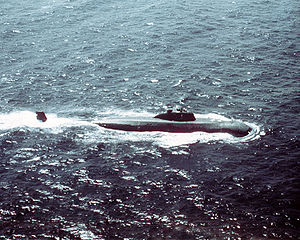Loading AI tools
Soviet nuclear-powered attack submarine From Wikipedia, the free encyclopedia
The Victor class, Soviet designations Project 671 Yorsh, Project 671RT Syomga and Project 671RTM/RTMK Shchuka, (NATO reporting names Victor I, Victor II and Victor III, respectively), are series of nuclear-powered attack submarines built in the Soviet Union and operated by the Soviet Navy. Since the 1960s, 48 units were built in total, of which the last remaining are currently in service with the Russian Navy. The Victor-class submarines featured a teardrop shape, allowing them to travel at high speed. These vessels were primarily designed to protect Soviet surface fleets and to attack American ballistic missile submarines. Project 671 began in 1959 with the design task assigned to SKB-143 (one of the predecessors of the Malakhit Marine Engineering Bureau).
This article needs additional citations for verification. (August 2021) |
 A Victor I-class submarine underway | |
| Class overview | |
|---|---|
| Name | Victor class |
| Builders | Sudomekh Shipyard |
| Operators | |
| Preceded by | November class |
| Succeeded by | Alfa class, Akula class |
| In commission | 1967–present |
| Completed | 48[1] |
| Active | 2 |
| Retired | 46 |
| General characteristics | |
| Type | Nuclear attack submarine |
| Displacement |
|
| Length | 93–102 m (305 ft 1 in – 334 ft 8 in) |
| Beam | 10 m (32 ft 10 in) |
| Draft | 7 m (23 ft 0 in) |
| Propulsion | One VM-4P pressurized-water twin nuclear reactor (2x75 MW), 2 sets OK-300 steam turbines; 1 7-bladed or 2 4-bladed props; 31,000 shp (23,000 kW) at 290 shaft rpm – 2 low-speed electric cruise motors; 2 small props on stern planes; 1,020 shp (760 kW) at 500 rpm Electric: 4,460 kw tot. (2 × 2,000-kw, 380-V, 50-Hz a.c. OK-2 turbogenerators, 1 × 460-kw diesel emergency set)[verification needed] |
| Speed | 32 knots (59 km/h; 37 mph) |
| Endurance | 80 days |
| Complement | About 100 (27 officers, 34 warrant officers, 35 enlisted) |
| Sensors and processing systems |
|
| Armament |
|
Soviet designation Project 671 Yorsh (ruffe)—was the initial type that entered service in 1967; 16 were produced.[2] Each had six torpedo tubes for launching Type 53 torpedoes and SS-N-15 anti-submarine missiles and mines could also be released. Subs had a capacity of 24 tube-launched weapons or 48 mines (or a combination). They were 92.5 m (303 ft) long. All disposed.[3]
Soviet designation Project 671RT Syomga (atlantic salmon)—entered service in 1972; seven were produced in the 1970s.[2] These were originally designated Uniform class by NATO. They had similar armament to the Victor I class and were the first Soviet submarines to introduce raft mounting for acoustic quieting.[4] Production was truncated due to a decision to develop the improved Victor III class.[4] They were 101.8 m (334 ft) long. All disposed.[5]
Soviet designation Project 671RTM/RTMK Shchuka (pike)—entered service in 1979; 25 were produced until 1991.[2] Quieter than previous Soviet submarines, these ships had four tubes for launching SS-N-21 or SS-N-15 missiles and Type 53 torpedoes, plus another two tubes for launching SS-N-16 missiles and Type 65 torpedoes. 24 tube-launched weapons or 36 mines could be on board. The Victor III class caused a minor furor in NATO intelligence agencies at its introduction because of the distinctive pod on the vertical stern-plane. Speculation immediately mounted that the pod was the housing for some sort of exotic silent propulsion system, possibly a magnetohydrodynamic drive unit. Another theory proposed that it was some sort of weapon system.[citation needed] In the end, the pod was identified as a hydrodynamic housing for a reelable towed passive sonar array;[6] the system was subsequently incorporated into the Sierra and Akula-class SSNs. In October 1983 the towed array of K-324, a Victor III operating west of Bermuda, became tangled with the towed array of US frigate USS McCloy. K-324 was forced to surface, allowing NATO forces to photograph the pod in its deployed state. The Victor-III class was continuously improved during construction and late production models have a superior acoustic performance.[7] They were 106 m (348 ft) long. 21 disposed.[8]
| # | Name | Project | Laid down | Launched | Commissioned | Fleet | Status | Notes |
|---|---|---|---|---|---|---|---|---|
| B-138 | Obninsk | 671RTMK | 7 December 1988 | 5 August 1989 | 30 December 1990 | Northern Fleet | Refit? | Overhauls completed in 2014, 2016[9] |
| B-448 | Tambov | 671RTMK | 31 January 1991 | 17 October 1991 | 24 September 1992 | Northern Fleet | Active?[10] | Reported as "received" in early 2023[11][12] |

This section needs additional citations for verification. (March 2021) |
Seamless Wikipedia browsing. On steroids.
Every time you click a link to Wikipedia, Wiktionary or Wikiquote in your browser's search results, it will show the modern Wikiwand interface.
Wikiwand extension is a five stars, simple, with minimum permission required to keep your browsing private, safe and transparent.